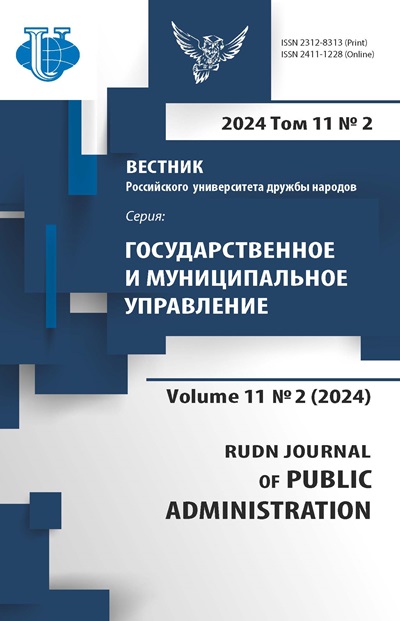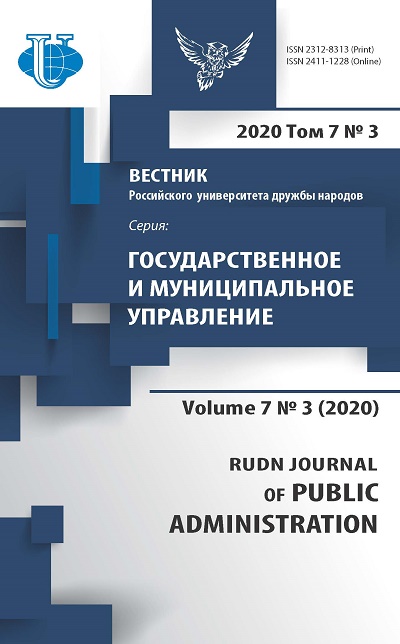Влияние инициированных ПРООН проектов на социально-экономическое развитие женщин: исследование сельских районов Пенджаба, Пакистан
- Авторы: Нисар Р.Д.1
-
Учреждения:
- Центральный китайский педагогический университет
- Выпуск: Том 7, № 3 (2020)
- Страницы: 272-284
- Раздел: МЕЖДУНАРОДНЫЙ ОПЫТ ГОСУДАРСТВЕННОГО УПРАВЛЕНИЯ
- URL: https://journals.rudn.ru/public-administration/article/view/24522
- DOI: https://doi.org/10.22363/2312-8313-2020-7-3-272-284
Цитировать
Полный текст
Аннотация
Женщины составляют половину всего населения мира, при этом их положение по всему миру резко различается. Проблема расширение прав и возможностей женщин в XXI веке приобрела гораздо большую важность, чем прежде. Является доказанным фактом то, что без расширения возможностей половины населения страна не может достичь процветания в любой области. Целый ряд правительственных и неправительственных организаций интенсивно работают над вопросом расширения прав и возможностей женщин, не вызывает сомнений особый вклад Организации Объединенных Наций (ООН) в этой области, прежде всего заключающийся в том, что ее устав гарантирует основные права женщин. В течение последних двух десятилетий ООН было проведено много конференций, семинаров и практикумов по правам женщин в рамках глобального движения. Ряд учреждений ООН работают над этим вопросом, но наиболее эффективная работа по расширению прав и возможностей женщин была проведена Программой развития Организации Объединенных Наций (ПРООН). Она работает по всему миру путем пропагандирования, партнерства и предоставляет техническую поддержку и финансовую помощь правительственным и неправительственным организациям. В Пакистане женщины составляют 51,73% от общей численности населения. Положение женского населения, особенно в сельской местности, является в целом неблагоприятным. Часто женщины лишены своих основных прав, и уровень грамотности среди женщин также угрожающе низок. Будучи развивающимся государством, Пакистан зависит от финансовой помощи и технической поддержки со стороны международных агентств. После 18-й поправки к Конституции провинции страны получают всевозможную помощь непосредственно от учреждений-доноров. Сегодня из-за тяжелой ситуации в сельской местности страны «ПРООН Пакистан» работает в том числе над подъемом уровня жизни сельского населения. В этом статье подробно освещены социально-экономические последствия программы ПРООН для женщин.
Ключевые слова
Об авторах
Рана Даниш Нисар
Центральный китайский педагогический университет
Автор, ответственный за переписку.
Email: ranadanishnisar@gmail.com
ORCID iD: 0000-0002-1354-5144
аспирант Школы политики и международных исследований
№ 152, Лоую Роад, 430079, Ухань, Хубэй, Китайская Народная РеспубликаСписок литературы
- The Millennium Development Goals Report 2013. United Nations. New York: UN; 2013.
- UNDP Pakistan Annual Report 2011. UNDP Pakistan. Islamabad: UNDP Pakistan; 2011.
- Electoral cycle support to the Election Commission of Pakistan. UNDP Pakistan. 2013. URL: http://www.pk.undp.org/content/pakistan/en/home/operations/projects/womens_empowerment/project_sample/. Accessed: 02.04.2020.
- Sharp Increase of Women Voters in Pakistan’s Recent Elections. UNWOMEN. 2013. URL: http://www.pakistanaffairs.pk/threads/54641-Sharp-Increase-of-Women-Voters-in-Pakistan%E2%80%99s-Recent-Elections. Accessed: 02.04.2020.
- Turnout Comparison of Election Result 2008 & 2013 (National Assembly). Election Commission of Pakistan. 2013. URL: http://ecp.gov.pk/Misc/GE-2013-Graphs/02_na_turnout_comparison.png. Accessed: 03.04.2020.
- United Nations Development Programme. Goodwill ambassadors. 2013. URL: http://www.undp.org/content/undp/en/home/ourwork/goodwillambassadors.html. Accessed: 03.04.2020.
- 448 Women Candidates Contesting on General Seats. Immamudin Business Recorder. 07.05.2013.
- From Words to Action: An Introduction to GJP Supported Initiatives to Combat Violence Against Women (VAW). UNDP Pakistan. Islamabad: UNDP Pakistan; 2007.
- 2010 Floods in Pakistan - A Race Against Time! UNDP Pakistan. Islamabad: UNDP Pakistan; 2010.
- Part II: One Programme Progress in Pakistan. Pakistan One UN Programme Report. Islamabad: The United Nations System in Pakistan Publication; 2012: 20-47.
- Pakistan Social and Living Standards Measurement Survey (Pslm) 2010-11 Provincial / District. Islamabad: Pakistan Bureau of Statistics, Government of Pakistan; 2011.
- About UNDP in Pakistan. UNDP Pakistan. 2013. URL: http://www.pk.undp.org/content/pakistan/en/home/operations/about_und.html. Accessed: 05.04.2020.
- Project Punjab 2006. Soroptimist. 10.12.2006. URL: http://www.soroptimistinternational.org/our-projects/december-10appeal/project-punjab. Accessed: 05.04.2020
- Shaheed F. Preface in Women in Pakistan: General Conditions, Approaches and Project Proposals for the Development of Vocational Qualification of Women in the Province of Punjab. Lahore: Vanguard Books Limited; 1992.
- About UNDP in Pakistan. UNDP Pakistan. 2013. URL: http://www.pk.undp.org/content/pakistan/en/home/operations/about_und.html. Accessed: 06.04.2020.
















